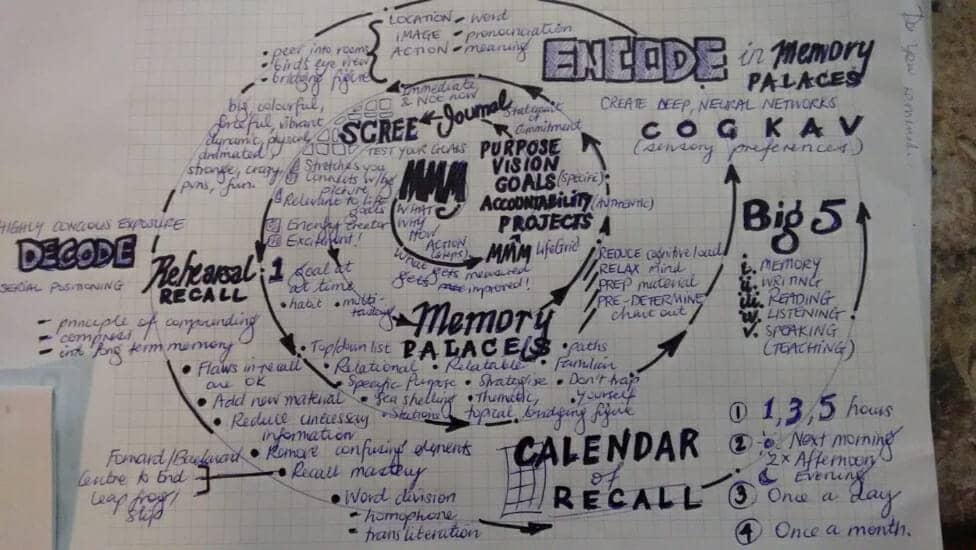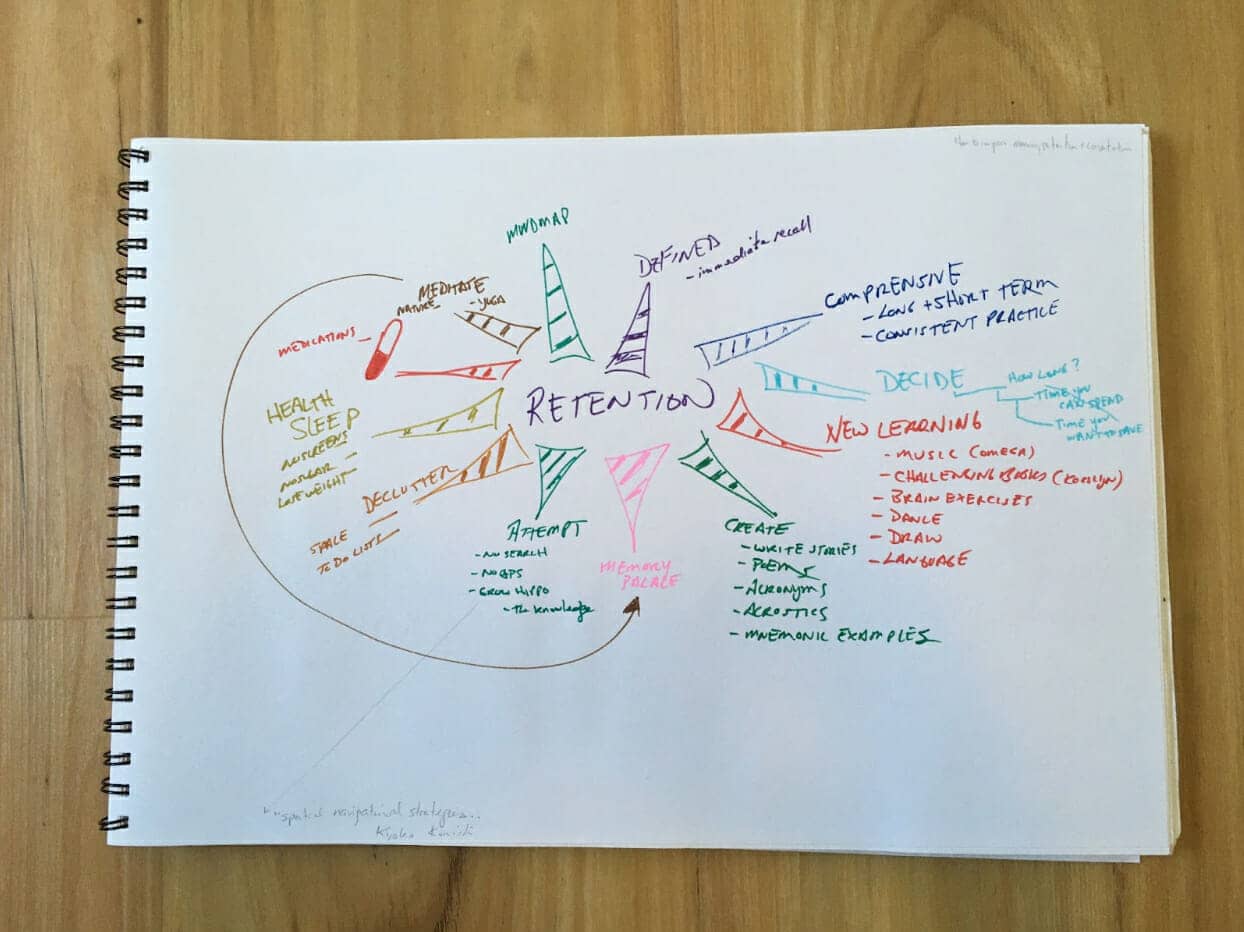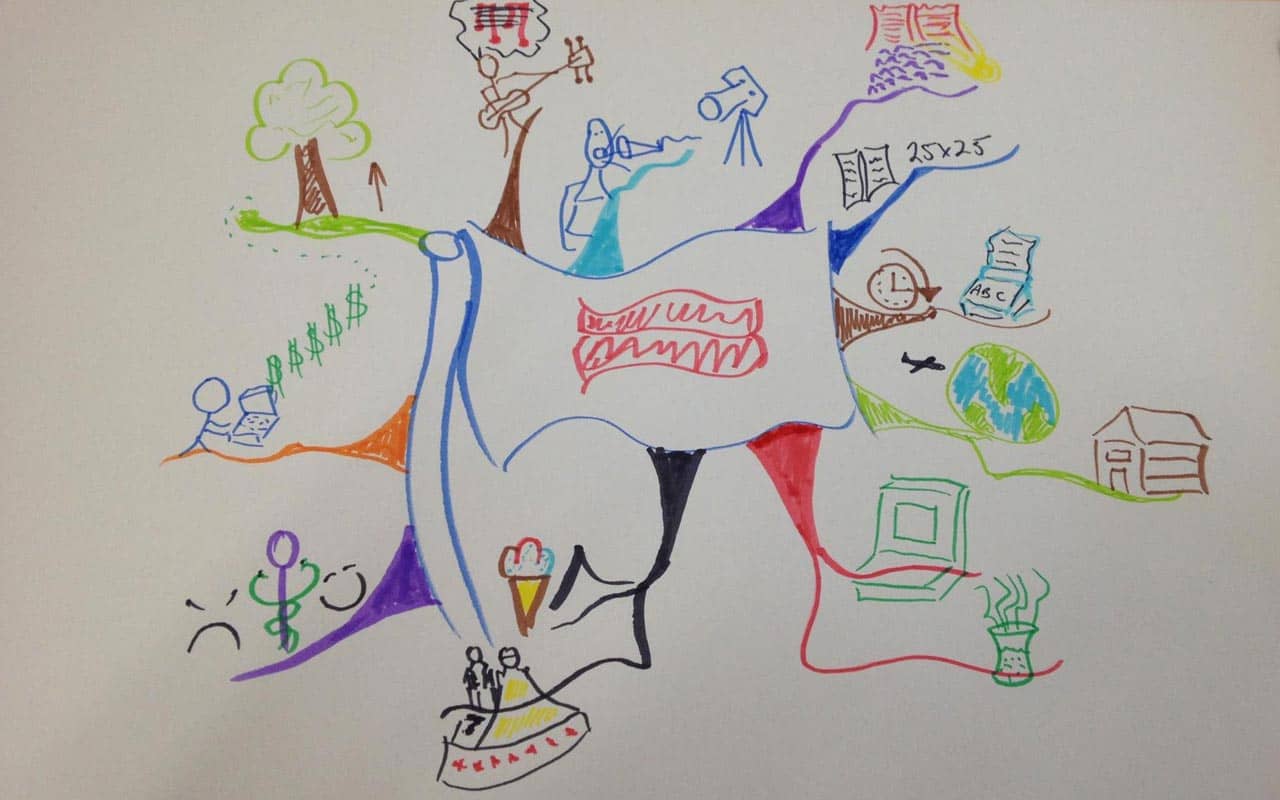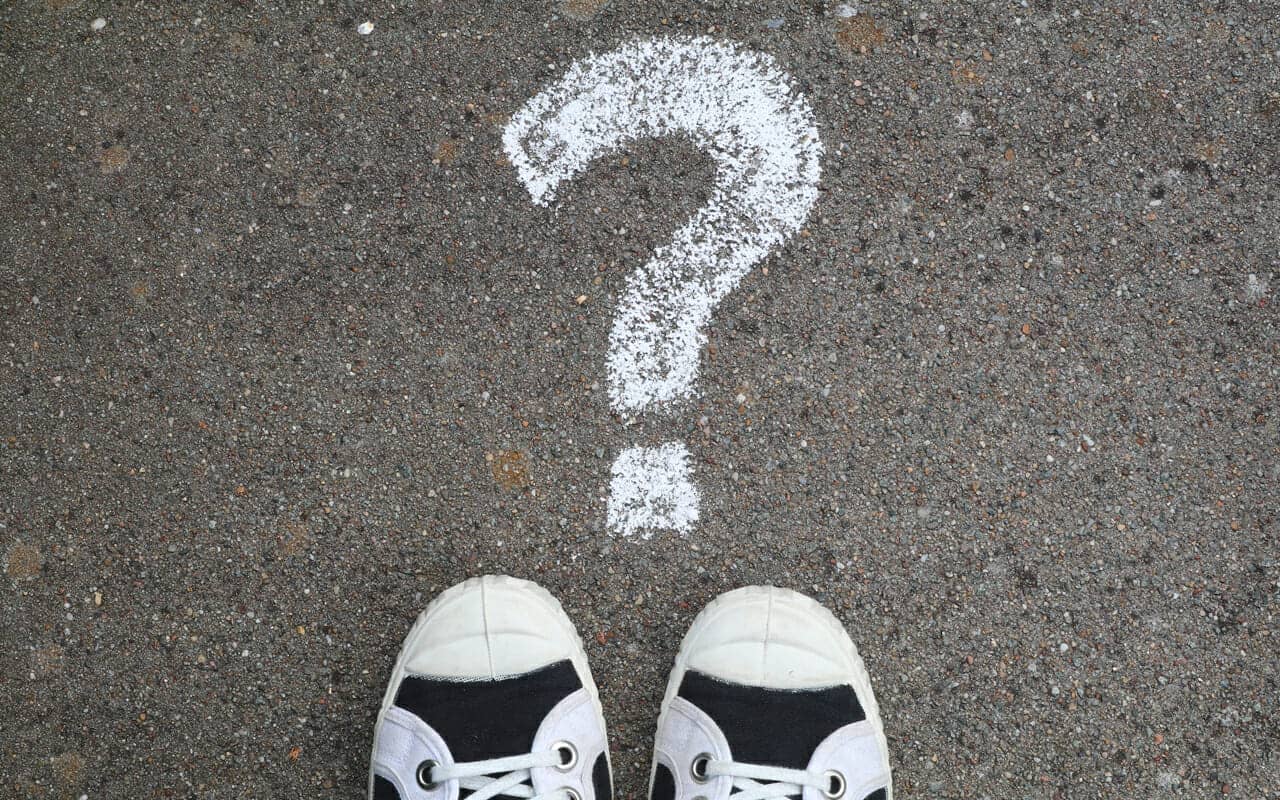Podcast: Download
Subscribe: Apple Podcasts | RSS
 You’ve probably heard of the chunking technique and thought it sounded pretty boring.
You’ve probably heard of the chunking technique and thought it sounded pretty boring.
I mean, how is splitting large pieces of information into smaller pieces supposed to help you remember more?
Isn’t that just more work?
Your intuition is correct to ask.
Because if the chunk method is poorly executed, it not only leads to wasted time and energy.
It doesn’t provide the desired results either.
So to fix that, let’s go beyond the standard chunking definition.
And I promise that after you’re read each and every example I have to share on this page, you’ll always get great results whenever you’re chunking information.
Ready?
Let’s dive in!
What is Chunking?
David Sousa gives a very simple way to understand chunking in How the Brain Learns.
Look at the word “chunking.”
Do your eyes and your brain see eight individual letters?
Technically, yes. But your mind “chunks” c-h-u-n-k-i-n-g into a single word.
We also tend to chunk numbers, such as the ones we use to call one another by phone. Whereas telephone numbers were initially very short, as the systems grew in popularity, they needed to be longer.
The term “chunking” comes from Dr. George Miller. In a 1956 paper titled The Magical Number Seven, Plus or Minus Two, he famously pointed out how grouping numbers into shorter chunks made them much easier to remember.
Many memory athletes and memory experts have used mnemonic devices like the PAO System to completely sidestep the limitations Miller identified and chunk in highly efficient ways. One of my students even memorized 1200 digits of pi and can recite them all in about a minute!
Experts provide another example. Instead of trying to understand vast swaths of disconnected information, they think categorically. They find and refer to patterns. And when necessary, experts create new terms or paradigms that help us understand the connections between aspects of the world.
Finally, some students treat “cramming” as a form of chunking. Although this practice can provide some results, one of my favorite memory hacks is called “The Cram Smasher.” It helps you group blocks of time in a sophisticated way that reduces forgetting and maximizes your free time.
How the Chunking Technique Works
Chunking is not necessarily a natural behavior. It tends to be a skill we learn. For example, when we are young, we are shown how ten dimes make a dollar.
There are many patterns like this that we learn: ten, ten dollar bills make one hundred, etc.
But to turn this into a memory strategy, we want to add a few additional elements. We can look for patterns and then group information deliberately.
Things You Can Remember Better With The Chunking Memory Strategy
You can learn many things faster using chunking.
Some of the classics include:
- Music (especially using the Circle of Fifths)
- Foreign language vocabulary and phrases
- First and last names
- Facts and trivia
- Numbers
Let’s look a bit closer at numbers by using an example like 9289.
In this number, you might notice that your grandfather is 92 and in 1989 he took you to the zoo. By comparing or mentally linking those similarities, you are chunking them together. Instead of looking at 9289 as a random digit, you have chunked it down and encoded smaller parts of the larger digit with personal meaning.
How Memory Competitors Use Chunking
You can also use the PAO System I mentioned above or the Major System. These are the mnemonic systems used by memory competitors to win prizes and break records each and every year going back for over three decades.

The Major works by translating each digit from 0-9 into a consonant. You then use those consonants to make words. 9289, for example, could become Peter Pan vaping – a chunk that works because P = 9, N =2 and V = 8. Using these facts about the Major System, you assign words that you find striking and recall numbers a lot easier.
Chunking Using Linking And Stories
Another way to chunk items together involves applying stories and links. For example, let’s say you need to memorize the following list of words:
- Kitten
- Field
- Football
- Drink
- Hunting
- Ocean
To remember these items, you could chunk them together using a story. For example, you can imagine a kitten in a field playing football. After the game, the kitten grabs some beers, puts on a hunting cap and goes to the ocean.
Yes, the story is weird, but it chunks the items in the list together, making them much easier to recall. Scientists have shown that this approach words by specifically expanding your working memory.
But the tactics we’ve covered so far aren’t the only ways to chunk. Let’s have a look at a few more.
7 Powerful Chunking Memory Techniques
As you go through this list, pick at least one and apply it to something you’re learning.
As always, you’ll want to ask before getting started with any particular chunking technique if it’s really appropriate to the learning goal. Sometimes there are more appropriate strategies available, though we never know until we experiment. So above all, have fun.
One: Make An Acronym
I’ve given a lot of speeches in my career. But sometimes I don’t feel like memorizing them word for word.
So I craft an acronym instead. Often, an entire talk comes from one keyword, a strategy I outline in detail in How to Memorize a Speech Fast.

You can also use acronyms to memorize definitions or phrases. The catch is that it can take a bit of time to think up a good one. It’s still powerful when you hit upon something good, and we use chunking like this all the time for news networks (CNN) and government institutions (FBI, CIA).
A recent popular example is YOLO for “you only live once.” This acronym chunks the concept into a unique word, but the phrase itself is itself chunking because it expresses a much longer sentiment in just a few words.
Even better, scientific research has shown that using acronyms can help you get focused again on certain tasks after an interruption. Acronyms have this effect because they provide your procedural memory a more robust structure to refer back to after an interruption.
Two: Mind Map
Mind mapping doesn’t have to involve chunking, but it certainly can.
Here are a few ways I’ve chunked related ideas to remember and recall concepts in memory through mind mapping.
Basically, ever image on a mind map chunks together and image with a concept or keyword you want to remember. Have a look at this example from one my students in the Magnetic Memory Method Masterclass:
Keko used my concept of the “Seashell Mind Map” to place various steps in the memory improvement process in order. Using big words, she can see larger concepts and understand what they are at a glance. In many ways, what Keko has created is a combined mind map and concept map.
Here’s an example of one of my own mind maps:
The central keyword is “retention” and I use tributaries in different colors to isolate different concepts. I’m using as few words as possible so that they are all chunked down to their key ideas on the mind map.
In one case, I included a drawing, which is a great way to include imagistic chunking as a memory strategy. In this final mind map example, I use all images and no words to remind me of the most important activities in my professional life as a memory teacher and researcher:
Each image chunks down an entire world of ideas. For example, in the 3 o’clock position, you see a clock and some letters on a typewriter. These images chunk down the idea that I will spend an hour a day writing. The medical symbol at the 7 o’clock position reminds me of my goal to work on my medical mnemonics podcast, especially on topics related to neuroscience and mental health (hence the unhappy and the happy faces).
In each of these mind map examples, chunking is used slightly differently. But the point remains the same: highly compressed mental connections are laid out on the space of the mind map. They are understood at a glance even though there are very few words on them, and in some cases no words at all.
Three: Compare and Contrast
One of the ways I remember so much as I read comes down to thinking comparatively.
For example, when I come across a main point in a book, I often ask, “What else is like this? What contrasts or opposes this?”
To give a simple example, I recently read Christopher Kemp’s Dark and Magical Places. It’s about how the brain navigates space. When I asked about the opposite of navigation, I thought about certain meditation practices where you sit very still.
When your questioning produces answers, even if they are very simple, you effectively chunk the ideas together. The chunking effect makes all of the involved information easier to remember in the future.
Asking questions also makes it possible to read faster because of how it develops your pattern recognition abilities.
Four: Notice Structures, Categories and Functions
We often just consume entertainment. But if we take some time to pay attention to the form a story takes, we can remember more about it.
I shared some of the narratological structures I used to use as a Film Studies professor in How to Remember a Story.
You can also use certain observations to help remember names.
For example, if you’re at the dentist and you learn that the secretary’s name is Martina, you could imagine your dentist drinking a toothpaste flavored martini with her at the service counter. You’ve literally chunked a dentistry related flavor to her name and put your dentist into the picture so you’ll remember that she’s his secretary.
Speaking of names, yet another way to understand chunking is to consider your last name. It’s one of many ways your identity is chunked to your family. The use of family trees to track lineage is another.
Five: Use Memory Techniques
Did you know that there are over 20 memory techniques to choose from?
These include rhyming, the Memory Palace technique and some of the number systems we discussed above.
In many ways, the Memory Palace is the ultimate chunking technique because you group the information you want to remember into individual rooms.
If you’d like to learn more about how it works, get my FREE Memory Improvement course for some free lessons and exercises:
Six: Inverse Chunking
So far, we’ve seen that chunking is all about grouping or organizing information in particular ways.
But another way to approach grouping information involves how you organize it in time.
For example, I love to use a reading technique called interleaving. Basically, it involves reading 3-5 books at the same time and switching between them.
Instead of chunking the topics or information in them, it’s about chunking the time down into manageable bits. Then, during the brakes, diffuse thinking helps form more memory connections. You literally learn and remember information about the first topic while paying attention to the second.
Seven: Flash Card Chunking
A lot of people like to use Anki or standard flashcards.
Although both are great and you can certainly chunk information onto cards categorically, it’s also possible to insert questions and connections into them to help you remember things.
In the example above, I used a question to contrast a point. Although this line of questioning might not make sense to you, it instantly reminds me that many spiritual traditions have very different goals than Marxism.
You can use questions like this to also help you compare, contrast and ultimately remember more.
Use the Chunking Technique Widely
As you can see, chunking is powerful.
How and when humans started gathering things together is not entirely clear. But as Dr. Miller pointed out, there’s only so much information the brain can easily contain.
But that’s where the techniques you’ve learned today provide some very good news.
By using the chunk method in its many forms strategically, it’s possible to learn faster and remember more.
So what do you say? Are you ready to get out there and master more information quickly?
Chunk it up!
Related Posts
- Memory Improvement Techniques For Kids
You're never too young to get started with memory techniques
- The Memory Code: Prehistoric Memory Techniques You Can Use Now
Lynne Kelly, author of The Memory Code, shares her personal experiences learning ancient memory techniques…
- Surviving PTSD With The Help of Memory Techniques Featuring Nicholas Castle
Nicholas Castle used memory training and memory techniques to help heal his PTSD. Listen to…










